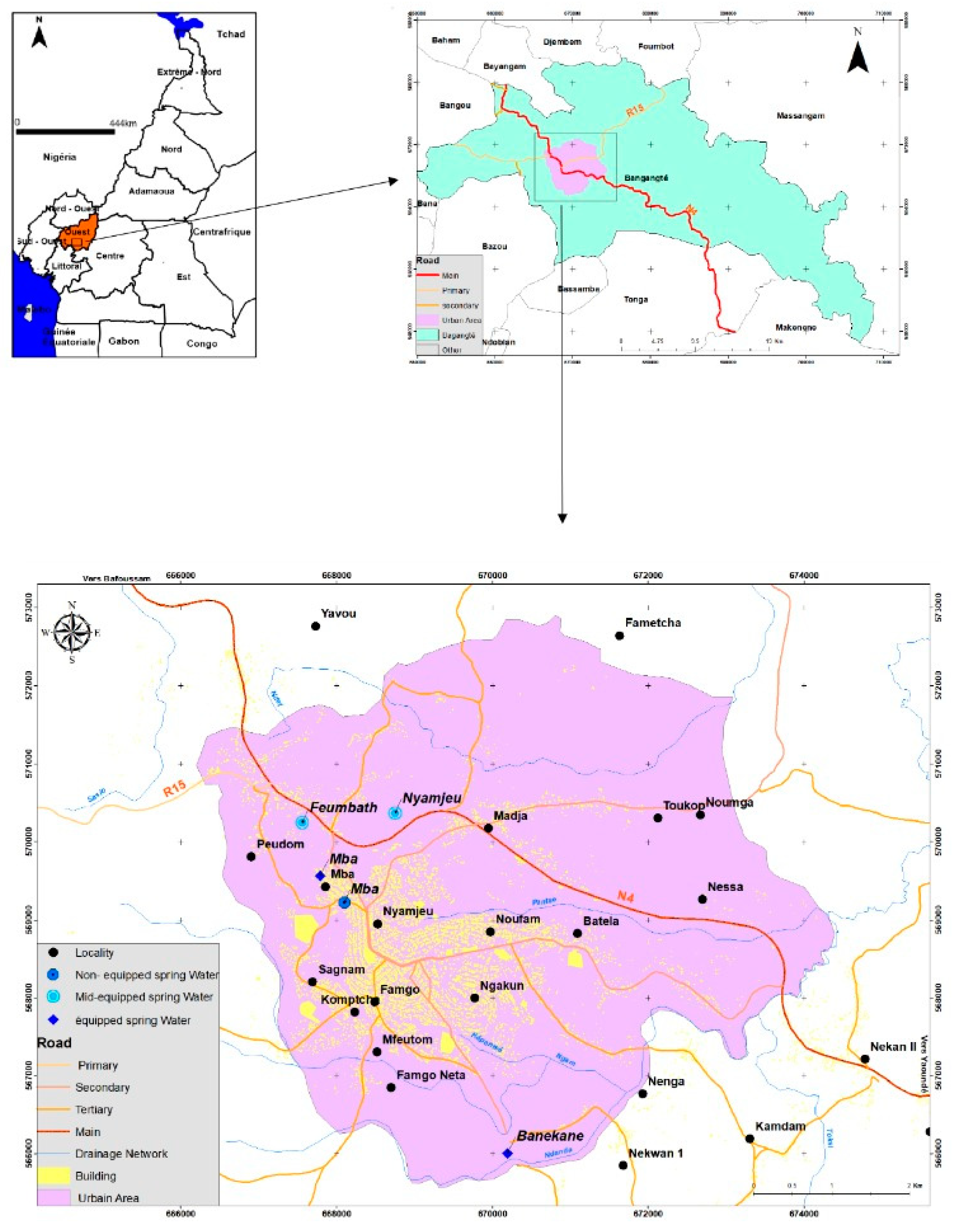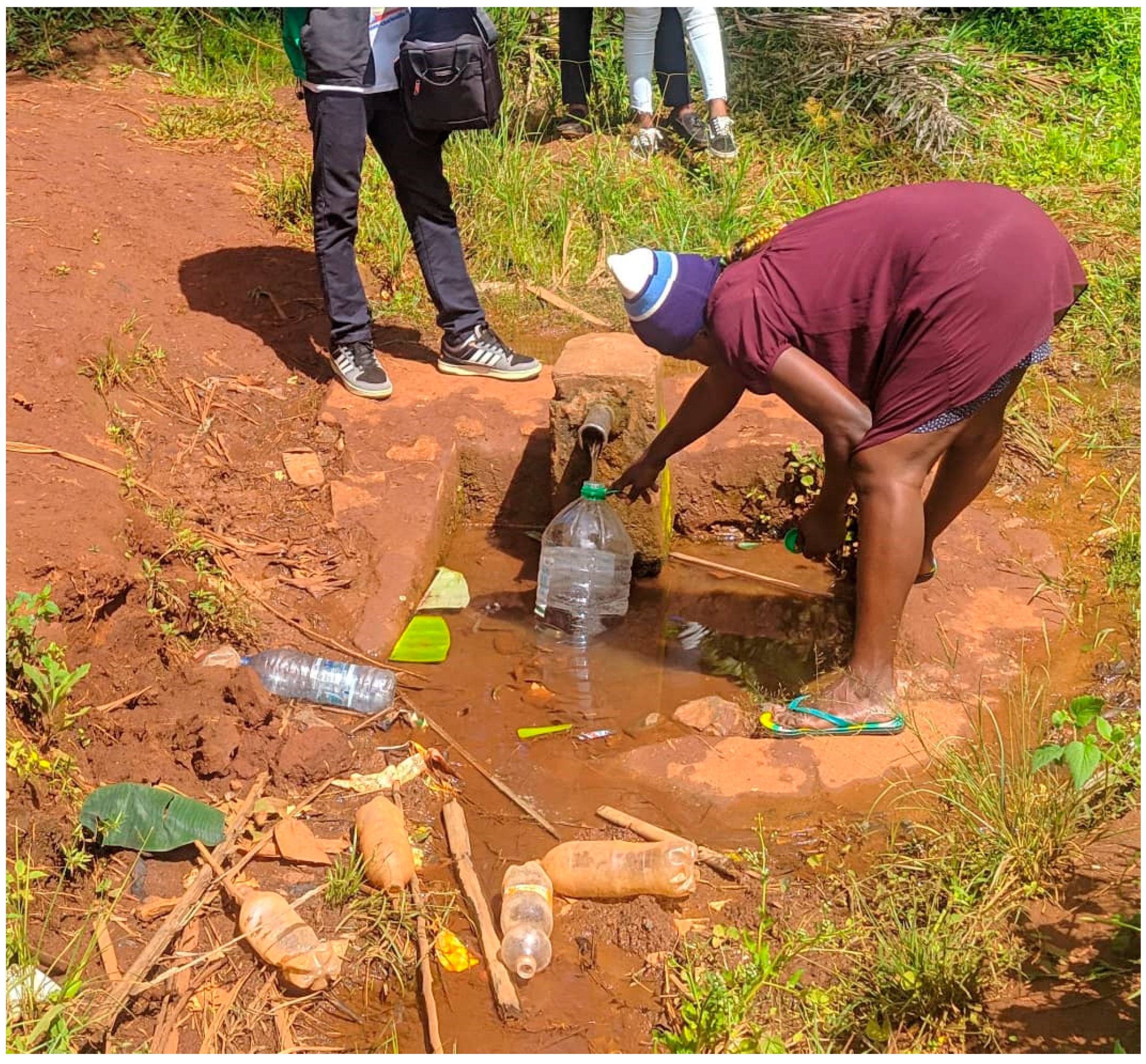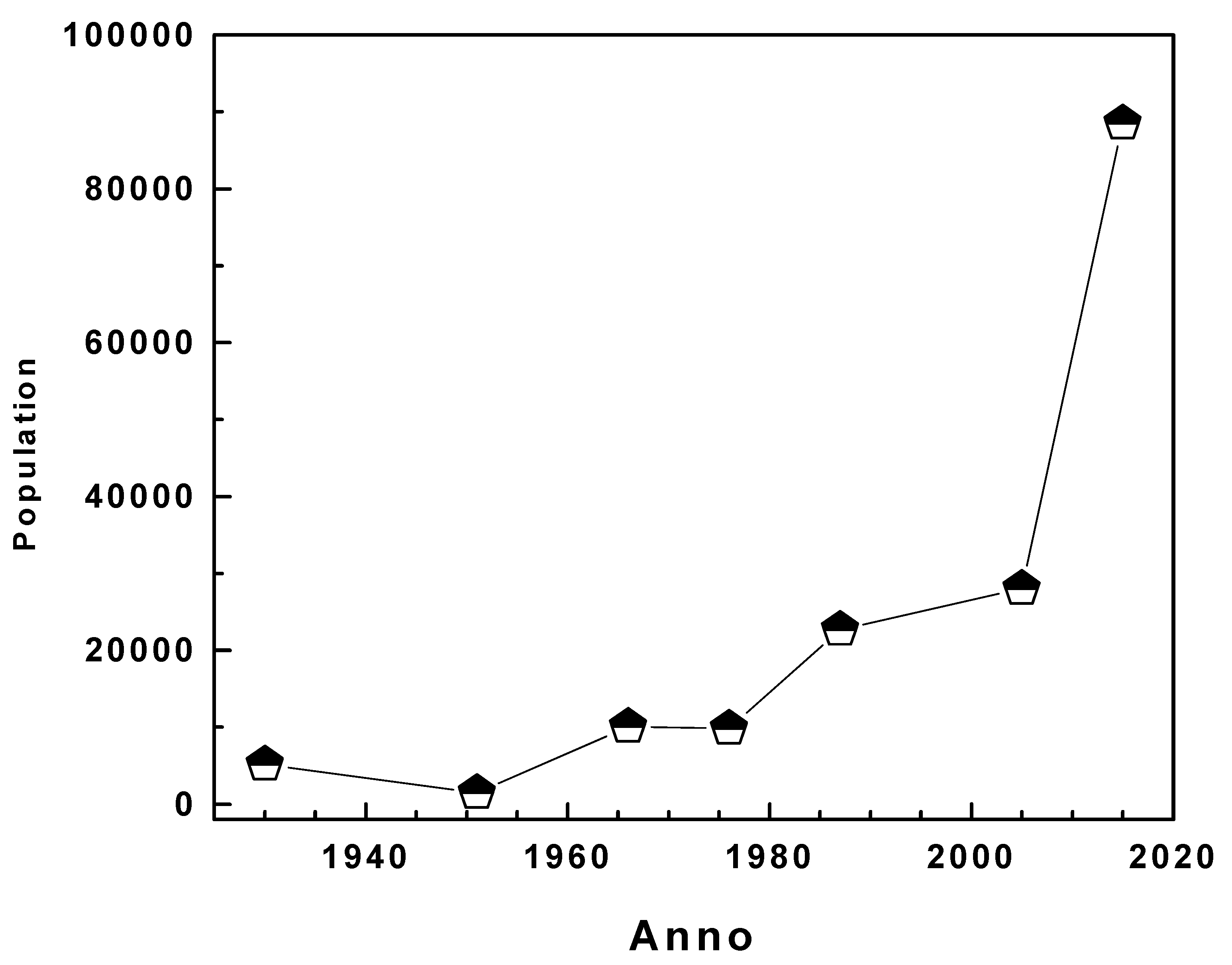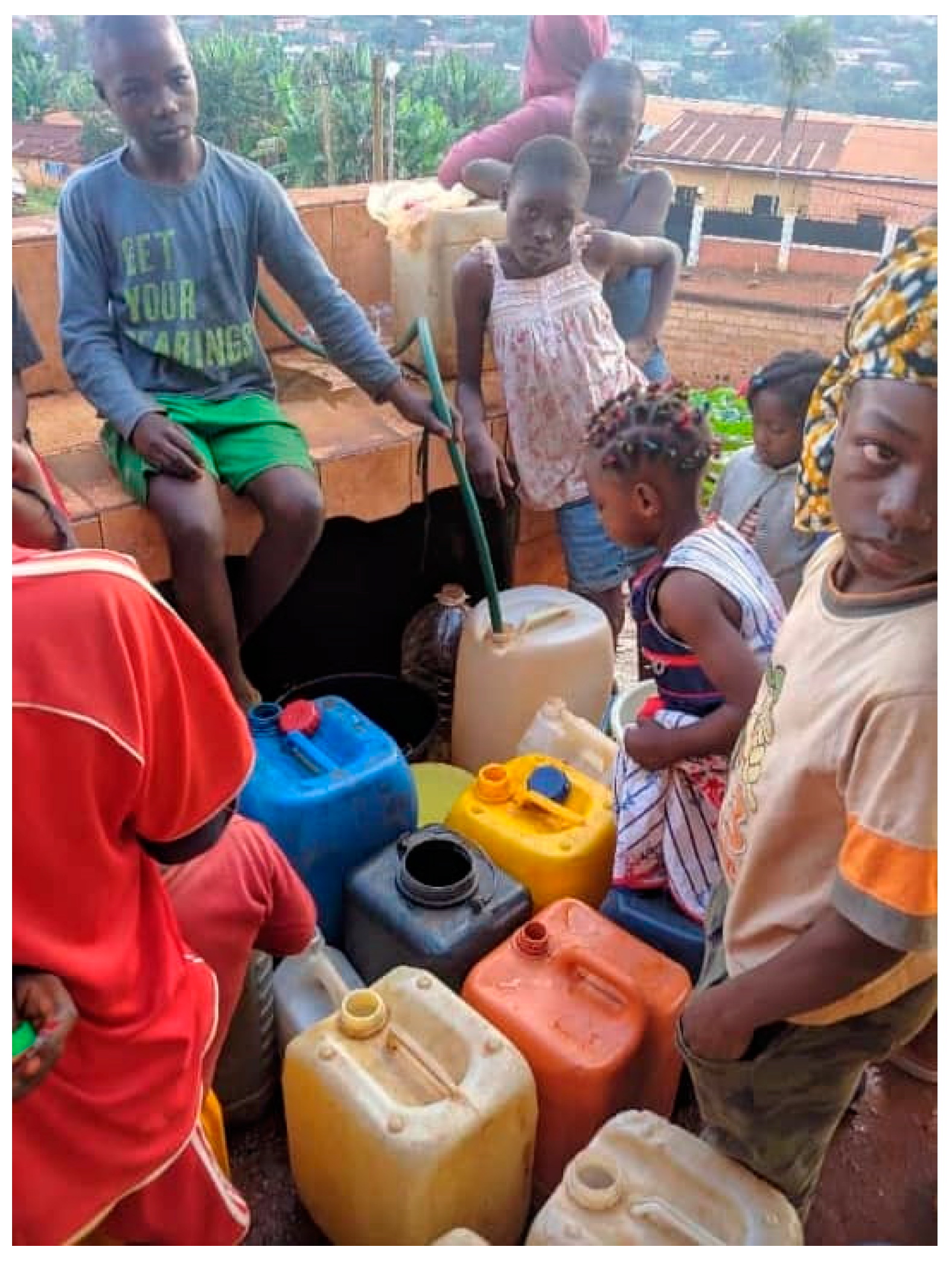A Hybrid Model for Achieving Universal Safe Drinking Water in the Medium-Sized City of Bangangté (Cameroon)
Abstract
:1. Introduction
2. An Overview of Bangangté
3. Drinking Water Supply System in Bangangté from the Colonial Period to 1980
4. Drinking Water Supply System in Bangangté from 1980 to 2020
5. Achieving the SDG 6.1 in Bangangté
6. Concluding Remarks
Supplementary Materials
Author Contributions
Funding
Institutional Review Board Statement
Informed Consent Statement
Data Availability Statement
Acknowledgments
Conflicts of Interest
References
- Hope, R.; Ballon, P. Global water policy and local payment choices in rural Africa. NPJ Clean Water 2019, 2, 21. [Google Scholar] [CrossRef] [Green Version]
- Adeniran, A.; Daniell, K.A.; Pittock, J. Water infrastructure development in Nigeria: Trend, size, and purpose. Water 2021, 13, 2416. [Google Scholar] [CrossRef]
- Hope, R.; Thomson, P.; Koehler, J.; Foster, T. Rethinking the economics of rural water in Africa. Oxford Rev. Econ. Pol. 2020, 36, 171–190. [Google Scholar] [CrossRef] [Green Version]
- Güneralp, B.; Lwasa, S.; Masundire, H.; Parnell, S.; Seto, K.C. Urbanization in Africa: Challenges and opportunities for conservation. Environ. Res. Lett. 2018, 13, 015002. [Google Scholar] [CrossRef]
- Nya, E.L. Access to Drinking Water and Sanitation in Nde Division, Cameroon. Ph.D. Thesis, University of Yaoundé I, Yaoundé, Cameroon, 2020. (In French). [Google Scholar]
- Furlong, K. STS beyond the “modern infrastructure ideal”: Extending theory by engaging with infrastructure challenges in the South. Technol. Soc. 2014, 38, 139–147. [Google Scholar] [CrossRef]
- Eberhard, R. Access to Water and Sanitation in Sub-Saharan Africa: Part I—Synthesis Report; Deutsche Gesellschaft für Internationale Zusammenarbeit (GIZ) GmbH: Berlin, Germany, 2019; Volume 1. [Google Scholar]
- Wydra, K.; Becker, P.; Aulich, H. Sustainable solutions for solar energy driven drinking water supply for rural settings in Sub-Saharan Africa: A case study of Nigeria. J. Photonics Energy 2019, 9, 043106. [Google Scholar] [CrossRef] [Green Version]
- Otter, P.; Sattler, W.; Grischek, T.; Jaskolski, M.; Mey, E.; Ulmer, N.; Grossmann, P.; Matthias, F.; Malakarh, P.; Goldmaier, A.; et al. Economic evaluation of water supply systems operated with solar-driven electro-chlorination in rural regions in Nepal, Egypt and Tanzania. Water Res. 2020, 187, 116384. [Google Scholar] [CrossRef] [PubMed]
- Huang, Z.; Nya, E.L.; Cao, V.; Gwenzi, W.; Rahman, M.A.; Noubactep, C. Universal access to safe drinking water: Escaping the traps of non-frugal technologies. Sustainability 2021, 13, 9645. [Google Scholar] [CrossRef]
- Schumacher, E.F. Small Is Beautiful: Economics as if People Mattered; Harper & Row: Manhattan, NY, USA, 1973; p. 324. [Google Scholar]
- Roy, B.; Hartigan, J. Empowering the rural poor to develop themselves: The barefoot approach. Innovations 2008, 3, 67–93. [Google Scholar] [CrossRef]
- Kearns, J.P. Biochar Adsorbent for Control of Synthetic Organic Contaminants in Affordable Decentralized Water Treatment. Ph.D. Thesis, University of Colorado, Boulder, CO, USA, 2016. [Google Scholar]
- Noubactep, C.; Schöner, A.; Woafo, P. Metallic iron filters for universal access to safe drinking water. CLEAN–Soil Air Water 2009, 37, 930–937. [Google Scholar] [CrossRef] [Green Version]
- Kearns, J. Sustainable decentralized water treatment for rural and developing communities using locally generated biochar adsorbents. Water Cond. Purif. Int. 2012, 54, 7–12. [Google Scholar]
- Noubactep, C. A framework for technology development in Africa: The case of metallic iron (Fe0) water filters for safe drinking water provision. In Science and Biotechnology in Africa 2020, Proceedings of a Conference on Scientific Advancement, Kigali, Rwanda 4–6 October 2017; Kapalanga, J., Raphael, D., Mutesa, L., Eds.; Cambridge Scholars Publishing: New Castle, UK; pp. 111–139.
- Huisman, L.; Wood, W.E. Slow Sand Filtration; WHO: Geneva, Switzerland, 1974. [Google Scholar]
- Howe, K.J.; Hand, D.W.; Crittenden, J.C.; Trussell, R.R.; Tchobanoglous, G. Principles of Water Treatment; John Wiley & Sons, Inc.: Hoboken, NJ, USA, 2012; p. 674. [Google Scholar]
- Amrose, S.E.; Cherukumilli, K.; Wright, N.C. Chemical contamination of drinking water in resource-constrained settings: Global prevalence and piloted mitigation strategies. Annu. Rev. Environ. Resour. 2020, 45, 195–226. [Google Scholar] [CrossRef]
- Pembe-Ali, Z.; Mwamila, T.B.; Lufingo, M.; Gwenzi, W.; Marwa, J.; Rwiza, M.J.; Lugodisha, I.; Qi, Q.; Noubactep, C. Application of the Kilimanjaro Concept in Reversing Seawater Intrusion and Securing Water Supply in Zanzibar, Tanzania. Water 2021, 13, 2085. [Google Scholar] [CrossRef]
- Oumar, S.B.; Tewari, D.D. The development of water management institutions and the provision for water delivery in Cameroon: History and futures. Ghana J. Dev. Stud. 2012, 9, 80–102. [Google Scholar] [CrossRef]
- Halvorson, S.J.; Wescoat, J.L., Jr. Guarding the sons of empire: Military–state–society relations in water, sanitation and health programs of mid-19th-century India. Water 2020, 12, 429. [Google Scholar] [CrossRef] [Green Version]
- Gilmartin, D. Scientific Empire and Imperial Science: Colonialism and Irrigation Technology in the Indus Basin. J. Asian Stud. 1994, 53, 1127–1149. [Google Scholar] [CrossRef]
- Hume, J.C., Jr. Colonialism and Sanitary Medicine: The Development of Preventive Health Policy in the Punjab, 1860–1900. Mod. Asian Stud. 1986, 20, 703–724. [Google Scholar] [CrossRef]
- von Puttkamer, J. Gouverneursjahre Im Kamerun; von Georg Stilke: Berlin, Germany, 1912. [Google Scholar]
- Nya, E.L.; Mougoué, B. Access to safe drinking water and sanitary risks in the town of Bangangté (West Region of Cameroon). Saudi J. Humanit. Soc. Sci. 2020, 5, 162–171. [Google Scholar]
- Third General Population and Housing Census in Cameroon; BUCREP: Yaoundé, Cameroun, 2010; p. 12.
- Elaboration Du Plan D’occupation Des Sols De La Commune De Bangangté: Analyse Diagnostique De La Situation Actuelle; MINHDU: Yaoundé, Cameroun, 2015; p. 282.
- Tchindjang, M. The Edge of the Bamileke Plateau around Bangangté. Master’s Thesis, University of Yaoundé, Yaoundé, Cameroun, 1985; p. 125. (In French). [Google Scholar]
- Tsalefac, M. Climatic Variability: Economic Crisis and Agrarian Dynamics in the Western Highlands of Cameroon. Ph.D. Thesis, University of Yaoundé I, Yaoundé, Cameroun, 1999; p. 564. (In French). [Google Scholar]
- Champaud, J. Villes Et Campagnes Du Cameroun De l’ouest; ORSTOM: Paris, France, 1983; p. 510. (In French) [Google Scholar]
- Njiké-Bergeret, C. Meine Afrikanische Leidenschaft; Bastei-Lübbe: Bergisch Gladbach, Germany, 1999. [Google Scholar]
- Nganso, E. Bangangté: Urban Study; DES, University of Yaoundé: Yaoundé, Cameroun, 1977. (In French) [Google Scholar]
- Sitcheping-Kuetche, C. Mise Au Point D’un Système De Traitement Collectif Des Eaux Usées Des Edifices Publics De La ville De Bangangte. Master’s Thesis, Ecole National des Travaux Publiques, Yaoundé, Cameroon, 2017. [Google Scholar]
- Nganso, E. The Lethargy of the Ndé Division: An Anomaly in the Bamiléké Dynamism. Ph.D. Thesis, University of Yaoundé, Yaoundé, Cameroon, 1982. (In French). [Google Scholar]
- Hamlin, C. A Science of Impurity: Water Analysis in Nineteenth Century Britain; University of California Press: Berkeley, CA, USA, 1990. [Google Scholar]
- Ndonko, P. Water management policies in Cameroon. J. Cult. Soc. Anthropol. 2021, 3, 8–16. [Google Scholar]
- Feumba, R.; Dongmo, K.T.; Youmbi, J.G.T.; Mvondo, V.Y.E.; Tchato, D.I.T.; Ngatcha, B.N. Assessment of hydraulic parameters and protection zones of catchment aquifers for water supply network in Nde Division, West-Cameroon (Central Africa). J. Water Resour. Prot. 2021, 13, 478–497. [Google Scholar] [CrossRef]
- 7.5 Million in 1976. Were Are 10.5 Million Inhabitants in 1987; BUCREP: Yaoundé, Cameroun, 1987; p. 35.
- PNDP; CAFER. Plan Communal de Développement de la Commune de Bangangté; Avril: Marua, Cameroon, 2015; p. 319. [Google Scholar]
- WHO (World Health Organization). Domestic Water Quantity, Service, Level and Health; World Health Organization: Geneva, Switzerland, 2003. [Google Scholar]
- Njoyim, E.B.T.; Menga, T.R.; Mofor, N.A.; Nchofua, F.B.; Njoyim, I.K. Evaluation of surface and ground water quality in the Bangangte municipality—West Cameroon. Int. J. Res. Rev. Appl. Sci. 2016, 28, 53–64. [Google Scholar]
- Ndé-Tchoupé, A.I.; Crane, R.A.; Mwakabona, H.T.; Noubactep, C.; Njau, K.N. Technologies for Decentralized Fluoride Removal: Testing Metallic Iron-based Filters. Water 2015, 7, 6750–6774. [Google Scholar] [CrossRef] [Green Version]
- Lilje, J.; Mosler, H.-J. Continuation of health behaviors: Psychosocial factors sustaining drinking water chlorination in a longitudinal study from Chad. Sustainability 2016, 8, 1149. [Google Scholar] [CrossRef] [Green Version]
- Kozicki, Z.A.; Baiyasi-Kozicki, S.J. The survival of mankind requires a water quality and quantity index (WQQI) and water applied testing and environmental research (WATER) centers. World Water Policy 2019, 5, 55–70. [Google Scholar] [CrossRef]
- Hubbart, J.A.; Gootman, K.S. Addressing drinking water security: A call to broaden investment in testing and community outreach. Challenges 2021, accepted. [Google Scholar]
- Marwa, J.; Lufingo, M.; Noubactep, C.; Machunda, R. Defeating fluorosis in the East African Rift Valley: Transforming the Kilimanjaro into a rainwater harvesting park. Sustainability 2018, 10, 4194. [Google Scholar] [CrossRef] [Green Version]
- Ndé-Tchoupé, A.I.; Tepong-Tsindé, R.; Lufingo, M.; Pembe-Ali, Z.; Lugodisha, I.; Mureth, R.I.; Nkinda, M.; Marwa, J.; Gwenzi, W.; Mwamila, T.B.; et al. White teeth and healthy skeletons for all: The path to universal fluoride-free drinking water in Tanzania. Water 2019, 11, 131. [Google Scholar] [CrossRef] [Green Version]
- Qi, Q.; Marwa, J.; Mwamila, T.B.; Gwenzi, W.; Noubactep, C. Making Rainwater Harvesting a Key Solution for Water Supply: The Universality of the Kilimanjaro Concept. Sustainability 2019, 11, 5606. [Google Scholar] [CrossRef] [Green Version]
- Huang, Z.; Nya, E.L.; Rahman, M.A.; Mwamila, T.B.; Cao, V.; Gwenzi, W.; Noubactep, C. Integrated water resource management: Rethinking the contribution of rainwater harvesting. Sustainability 2021, 13, 8338. [Google Scholar] [CrossRef]
- Pooi, C.K.; Ng, H.Y. Review of low-cost point-of-use water treatment systems for developing communities. NPJ Clean Water 2018, 1, 11. [Google Scholar] [CrossRef]
- Naseri, E.; Ndé-Tchoupé, A.I.; Mwakabona, H.T.; Nanseu-Njiki, C.P.; Noubactep, C.; Njau, K.N.; Wydra, K.D. Making Fe0-based filters a universal solution for safe drinking water provision. Sustainability 2017, 9, 1224. [Google Scholar] [CrossRef] [Green Version]
- Antia, D.D.J. Water Treatment and Desalination Using the Eco-materials n-Fe0 (ZVI), n-Fe3O4, n-FexOyHz[mH2O], and n-Fex[Cation]nOyHz[Anion]m [rH2O]. In Handbook of Nanomaterials and Nanocomposites for Energy and Environmental Applications; Kharissova, O.V., Torres-Martínez, L.M., Kharisov, B.I., Eds.; Springer Nature Switzerland: Basel, Switzerland, 2020. [Google Scholar] [CrossRef]
- Noubactep, C. Chap. 36, A Handbook of Environmental Toxicology: Human Disorders and Ecotoxicology. In Metallic Iron for Environmental Remediation: Prospects and Limitations; D’Mello, J.P.F., Ed.; CAB International: Wallingford, UK, 2020; pp. 531–544. [Google Scholar]
- Yang, H.; Hu, R.; Ndé-Tchoupé, A.I.; Gwenzi, W.; Ruppert, H.; Noubactep, C. Designing the next generation of Fe0-based filters for decentralized safe drinking water treatment. Processes 2020, 8, 745. [Google Scholar] [CrossRef]
- Devonshire, E. The purification of water by means of metallic iron. J. Frankl. Inst. 1890, 129, 449–461. [Google Scholar] [CrossRef]
- Mwakabona, H.T.; Ndé-Tchoupé, A.I.; Njau, K.N.; Noubactep, C.; Wydra, K.D. Metallic iron for safe drinking water provision: Considering a lost knowledge. Water Res. 2017, 117, 127–142. [Google Scholar] [CrossRef]
- Tepong-Tsindé, R.; Crane, R.; Noubactep, C.; Nassi, A.; Ruppert, H. Testing metallic iron filtration systems for decentralized water treatment at pilot scale. Water 2015, 7, 868–897. [Google Scholar] [CrossRef] [Green Version]
- Banerji, T.; Chaudhari, S. A cost-effective technology for arsenic removal: Case study of zerovalent iron-based IIT Bombay arsenic filter in West Bengal. In Water and Sanitation in the New Millennium; Nath, K., Sharma, V., Eds.; Springer: New Delhi, India, 2017. [Google Scholar]
- Tepong-Tsindé, R.; Ndé-Tchoupé, A.I.; Noubactep, C.; Nassi, A.; Ruppert, H. Characterizing a newly designed steel-wool-based household filter for safe drinking water provision: Hydraulic conductivity and efficiency for pathogen removal. Processes 2019, 7, 966. [Google Scholar] [CrossRef] [Green Version]
- Law No. 2019/024 on the General Cord of Decentralized Local Authorities; Cameroon; p. 123.
- Hulya, D.; Robertson, S.A. Access to Water in the Slums of the Developing World; Working Paper No. 57, International Policy Centre for Inclusive Growth (IPC-IG): Brasilia, Brazil, 2009. [Google Scholar]
- Domènech, L. Rethinking water management: From centralised to decentralised water supply and sanitation models. Doc. D’anàlisi Geogràfica 2011, 57, 293–310. [Google Scholar] [CrossRef]
- Jaglin, S. Networked services and features of African urbanization: Other path toward globalization. Espace Géographique 2012, 41, 51–67. [Google Scholar] [CrossRef]
- Kalugila, S. Housing Interventions and Its Influence on Urban Development: Opportunities and Challenges in Mixed Informal Settlements, in Dar es Salaam—Tanzania. Ph.D. Thesis, Bauhaus University Weimar, Weimar, Germany, 2014. [Google Scholar]
- Boakye-Ansah, A.S.; Schwartz, K.; Zwarteveen, M. Unravelling pro-poor water services: What does it mean and why is it so popular? J. Water Sanit. Hyg. Dev. 2019, 9, 187–197. [Google Scholar] [CrossRef]
- Kithiia, J.; Majambo, G. Motion but no speed: Colonial to post-colonial status of water and sanitation service provision in Mombasa city. Cities 2020, 107, 102867. [Google Scholar] [CrossRef]
- Meran, G.; Siehlow, M.; von Hirschhausen, C. Pipes, Taps and Vendors: An Integrated Water Management Approach; Discussion paper; German Institute for Economic Research: Berlin, Germany, 2020. [Google Scholar]
- Njoh, A.J. Colonization and sanitation in urban Africa: A logistics analysis of the availability of central sewerage systems as a function of colonialism. Habitat Int. 2013, 38, 207–213. [Google Scholar] [CrossRef]
- Koepke, M.; Monstadt, J.; Pilo, F.; Otsuki, K. Rethinking energy transitions in Southern cities: Urban and infrastructural heterogeneity in Dar es Salaam. Energy Res. Soc. Sci. 2021, 74, 101937. [Google Scholar] [CrossRef]





| Years | Production (m3) | Distribution (m3) | Loss (m3) | Production Deficit Due to Power Cut (m3) | Number of Active Customers | Number of Customers Served 24/24 H |
|---|---|---|---|---|---|---|
| 2005 | 292,408 | 185,257 | 107,151 | |||
| 2006 | 385,875 | 212,032 | 173,843 | |||
| 2007 | 442,381 | 204,914 | 237,467 | |||
| 2008 | 419,647 | 202,130 | 217,517 | |||
| 2009 | 323,621 | 222,381 | 101,240 | 2658 | ||
| 2010 | 290,202 | 198,986 | 91,216 | 81,338 | 2418 | |
| 2011 | 293,212 | 198,275 | 94,937 | 43,501 | 2569 | 414 |
| 2012 | 246,996 | 177,783 | 69,213 | 52,205 | 2672 | 519 |
| 2013 | 210,747 | 158,955 | 51,792 | 62,718 | 2693 | 539 |
| 2014 | 338,442 | 195,171 | 143,271 | 82,532 | 2600 | 578 |
| 2015 | 261,487 | 191,704 | 69,783 | 111,344 | 2688 | 513 |
| 2016 | 313,893 | 219,837 | 94,056 | 62,863 | 2939 | 792 |
| 2017 | 523,878 | 294,404 | 229,474 | 114,401 | 3004 | 1856 |
| 2018 | 415,748 | 230,206 | 185,542 | 56,055 | 3066 | 1928 |
| Urban Area of Bangangté | Total | ||||||
|---|---|---|---|---|---|---|---|
| Nyamjeu | Mba | Mfeutom | Batéla | ||||
| Main mode of drinking water Supply | Water Network | Number | 10 | 1 | 7 | 11 | 29 |
| Ratio (%) | 34.5 | 3.4 | 24.1 | 37.9 | 100.0 | ||
| Spring | Number | 53 | 80 | 16 | 0 | 149 | |
| Ratio (%) | 35.6 | 53.7 | 10.7 | 0.0 | 100.0 | ||
| Well | Number | 5 | 0 | 2 | 0 | 7 | |
| Ratio (%) | 71.4 | 0.0 | 28.6 | 0.0 | 100.0 | ||
| Borehole | Number | 33 | 4 | 5 | 0 | 42 | |
| Ratio (%) | 78.6 | 9.5 | 11.9 | 0.0 | 100.0 | ||
| Others | Number | 1 | 0 | 0 | 3 | 4 | |
| Ratio (%) | 25.0 | 0.0 | 0.0 | 75.0 | 100.0 | ||
| Total | Number | 102 | 85 | 30 | 14 | 231 | |
| Ratio (%) | 44.2 | 36.8 | 13.0 | 6.1 | 100.0 | ||
Publisher’s Note: MDPI stays neutral with regard to jurisdictional claims in published maps and institutional affiliations. |
© 2021 by the authors. Licensee MDPI, Basel, Switzerland. This article is an open access article distributed under the terms and conditions of the Creative Commons Attribution (CC BY) license (https://creativecommons.org/licenses/by/4.0/).
Share and Cite
Nya, E.L.; Feumba, R.; Fotsing Kwetché, P.R.; Gwenzi, W.; Noubactep, C. A Hybrid Model for Achieving Universal Safe Drinking Water in the Medium-Sized City of Bangangté (Cameroon). Water 2021, 13, 3177. https://doi.org/10.3390/w13223177
Nya EL, Feumba R, Fotsing Kwetché PR, Gwenzi W, Noubactep C. A Hybrid Model for Achieving Universal Safe Drinking Water in the Medium-Sized City of Bangangté (Cameroon). Water. 2021; 13(22):3177. https://doi.org/10.3390/w13223177
Chicago/Turabian StyleNya, Esther Laurentine, Roger Feumba, Pierre René Fotsing Kwetché, Willis Gwenzi, and Chicgoua Noubactep. 2021. "A Hybrid Model for Achieving Universal Safe Drinking Water in the Medium-Sized City of Bangangté (Cameroon)" Water 13, no. 22: 3177. https://doi.org/10.3390/w13223177






